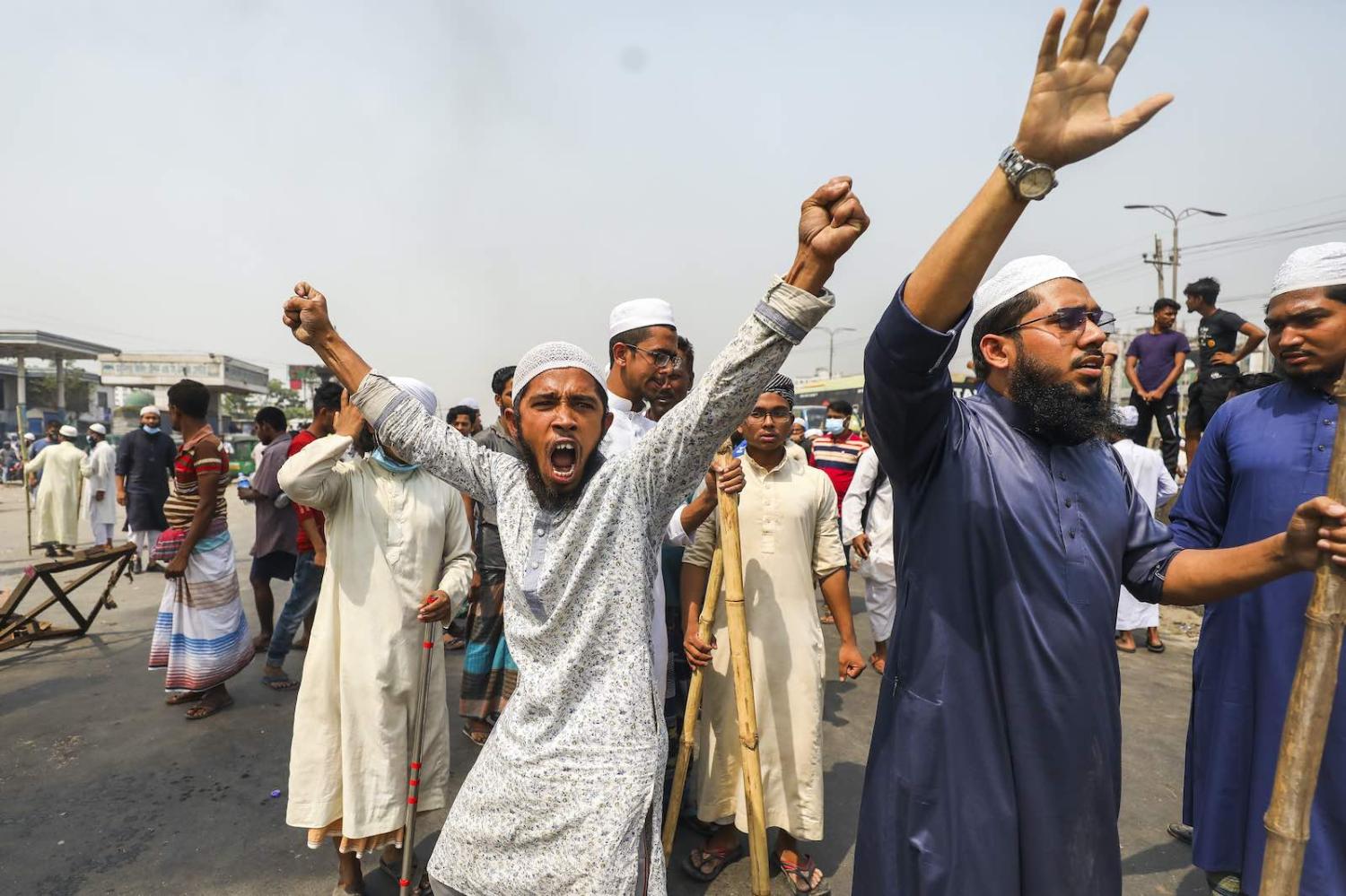India holds a special place in the history of the creation of Bangladesh. In 1971, under then–Prime Minister Indira Gandhi, India played a pivotal role in offering diplomatic, military and humanitarian support to the Bengalis’ quest for freedom from Pakistan. Therefore, to commemorate Bangladesh’s 50 years of independence, India’s Prime Minister Narendra Modi paid a two-day visit to Bangladesh on 26–27 March.
In the days prior to Modi’s visit, critics from the progressive left and centrist sections of Bangladeshi politics sought to stage a protest for what they said was mistreatment of minority Muslims in India, only for the demonstration to be ruthlessly suppressed by supporters of Bangladesh’s ruling party, the Awami League, backed by police.
However, the issue became more complicated when on the eve of Modi’s visit a countrywide protest campaign was led by the conservative orthodox group Hefazat-e-Islam Bangladesh, or HIB (the English translation of the group’s name is “safeguarding Islam in Bangladesh”).
Police shot dead four HIB activists in Hathazari, a subdistrict in the port city Chittagong, during what the activists claimed was a peaceful demonstration against Modi. Hathazari is home to the biggest and oldest madrassa (a school for Islamic instruction) in Bangladesh and headquarters to HIB. The group retaliated. At least 10 are now dead, while reportedly “four police stations, eight public offices, offices of the ruling party, Hindu temples and buses have been torched and vandalised”.
The usual heavy-handed reaction would only exacerbate further grievances and tension in an illiberal authoritarian context, which could eventually fuel extremism.
HIB grabbed public attention in 2013, having turned out more than a half million activists onto the street to effectively seize the capital city. The group had sprung from thousands of unregulated Qawmi madrassas across the country and demanded the government meet a 13-point manifesto, including the enactment of an anti-blasphemy law with provision for the death penalty, the cancellation of the national women’s development policy, a ban on constructing sculptures in public places, as well as on men and women mixing in public, and the demand to declare Ahmadis as non-Muslims, among other issues. The government of Prime Minister Sheikh Hasina’s government cracked down on the rally in May 2013 and, officially, at least 50 HIB activists were shot dead.
Yet unlike other major political parties and opposition groups, who have been significantly weakened due to persistent state suppression by the Awami League, HIB retained its stronghold through its network of hundreds and thousands of madrasas spread all over the country. The reason for this endurance is that HIB presents two significant and complex policy challenges entangled in the security, culture and history of the country.
First, HIB is not an Islamist party in the traditional sense. Although some of its leaders have Islamist affiliations, its strength lies in its institutional architecture as a networked organisation of madrassas teaching orthodox Islam. Unlike a political party or an Islamist outfit, HIB does not have any explicit political agenda to take power.
And although its protests have turned violent, HIB do not publicly espouse violent means. Many HIB activists hold attitudes similar to radical right groups in Europe, according to an examination of material and views espoused by the group.

Second, the historical and cultural roots HIB draws upon run deep in Bangladeshi society. In my own research, outlined in my book Islam and Politics: the Followers of Ummah, the origins of the group can be traced back to the British colonial period, when madrassa students and teachers supported Bengalis travelling to Turkey to fight against the British and preached against the British regime in Friday prayers.
After Bangladeshi independence, this orthodox base was a key pressure group behind the drive to declare Daud Haider, who now lives in permanent exile in Berlin, the first “blasphemous poet”, in 1974. It also played a pivotal role in 1994 to brand author Taslima Nasrin as a “blasphemous” writer, accusing her of disrespecting the Koran, Islam and Muslims. Nasrin also went into exile amid protests that turned out hundreds and thousands of conservative Muslims onto the streets in Dhaka under the banner of United Actions Council (UAC). Many of the demands made by the UAC then are similar to those outlined by HIB in 2013.
Despite this legacy of illiberalism, HIB is socially accepted because madrassas offer free boarding to hundreds of orphans, cater to the social need for Islamic rituals and services, and receive a significant part of zakat, charity payments that form an essential pillar of Islamic faith. In essence, the group has established itself as an authority over the image of Islam in highly conservative Bangladeshi society.
With a rising anti-Indian mindset in Bangladesh, the government must craft a careful and informed policy response to HIB. The usual heavy-handed reaction would only exacerbate further grievances and tension in an illiberal authoritarian context, which could eventually fuel extremism – the kind that Bangladesh has struggled with before. Keeping stability without creating further grievances in this increasingly strategically significant country amid a growing Indo-Pacific contest is a key challenge.

